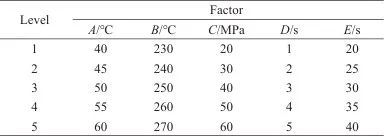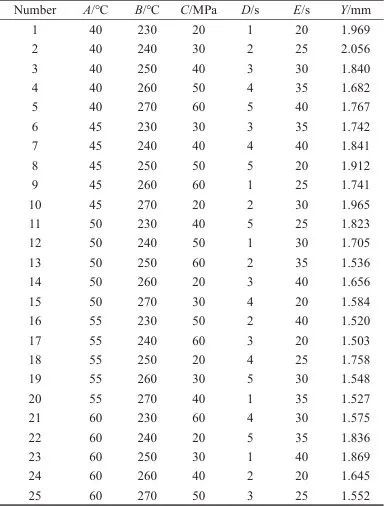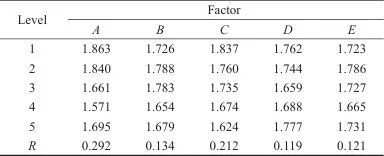Ningbo Institute of Technology, Zhejiang University: Optimization and Verification of Warpage Deformation of Automotive Front-End Framework Based on GA-BP Algorithm
Engineering Plastics Applications
2025-03-20 14:07:16
Abstract: In response to the issue of large warpage deformation at the grille slots of automotive front-end frames leading to poor overall vehicle assembly accuracy, a finite element model was first established using Moldflow software to analyze the initial warpage deformation and influencing parameters. Mold temperature, melt temperature, holding pressure, holding time, and cooling time were selected as design factors. An orthogonal experimental table was used to obtain the mapping relationship between process parameters and warpage deformation, and a single-objective nonlinear optimization model was established. A GA (Genetic Algorithm) improved BP (Back Propagation) neural network was further utilized to describe the nonlinear functional relationship of the optimization model. The fitness curve iterative convergence prediction yielded the optimal BP network model with predicted process parameters as follows: mold temperature 60 °C, melt temperature 265 °C, holding pressure 55 MPa, holding time 4 s, and cooling time 35 s, resulting in a maximum warpage deformation of 1.191 mm. Finally, the optimal process parameters were imported into Moldflow for simulation, yielding a maximum warpage deformation of 1.33 mm, which is a 45.1% reduction from the initial warpage value of 2.423 mm. After applying the GA-BP algorithm optimized process parameters in the production and manufacturing process, the deviation measurement results of the front-end frame injection molded parts showed that the actual measured values had a high degree of fit with the optimized Moldflow simulated values, with an average deviation of 0.28 mm, meeting the overall vehicle assembly requirements. This confirmed the feasibility of using the GA-BP neural network prediction model for optimizing the warpage deformation of the front-end frame.
Front-end framework is the installation and integration platform for various components in the engine space of the car's front, playing a crucial role in supporting the overall structure of the vehicle's head and having a significant impact on the vehicle's safety collision performance [1-2]. Traditional frameworks are generally made by welding sheet metal parts, which have complex processes and large mass. With the trend towards lightweight development of automobile cabin components and the emergence of high-strength plastic composite materials, all-plastic front-end frameworks have been widely applied [3].
The all-plastic front-end framework is prone to quality defects such as excessive warpage during the molding process, which in turn affects the assembly accuracy of automotive components [4-5]. To improve the quality of injection molded parts, optimizing the mold structure and selecting reasonable injection process parameters are more feasible implementation plans. Studies have shown that process parameters are a more significant factor affecting warpage [6-7]. In actual engineering production, technicians often rely on manual experience for trial molding to obtain injection molding parameters. However, this method involves a large number of trials, high economic costs, and a subjective optimization approach, which does not meet modern design requirements [8]. The intersection of Moldflow mold flow analysis software and artificial intelligence technology provides new ideas for the optimization of injection process parameters. Currently, many researchers have introduced intelligent algorithms to guide the actual production injection process. Wang Xiaodong et al. [9] used the total warpage of the socket cover as an optimization index, utilizing orthogonal experimental methods, BP neural network models, and genetic algorithms to find the optimal injection process parameters. Chen Zhonghang et al. [10] used Moldflow software to analyze the warpage deformation of plastic preforms, and through orthogonal experiments, range analysis, GABP neural network models, and PSO particle swarm algorithms, they found the optimal combination of process parameters to reduce warpage deformation. Guo et al. [11] established a neural network prediction model between eight process parameters and the warpage deformation of microcellular materials, collecting Moldflow simulated warpage deformation data using Latin hypercube sampling to compare the performance differences among the original BP neural network, GABP neural network, and PSOBP neural network. The results confirmed that the neural networks improved by intelligent algorithms had higher prediction accuracy. The above optimization targets focus on small-scale thin-walled injection-molded products, with few studies on the optimization of large, complex-structured automotive cockpit components. Compared to small injection-molded parts, the appearance size of the automotive front-end framework is larger, the mold structure is more complex, and the injection process has multi-stage and multi-segment parameter characteristics. Random changes in each process parameter during the molding process can easily cause differences in processing performance at different parts of the front-end framework. Therefore, it is necessary to fully consider the deformation trend of the component and quantify the warpage deformation value in the early stages of mold flow analysis and mold design. This helps achieve the goal of obtaining high-quality products at low economic cost.
The author introduces modern design methods in the design verification stage of the automotive front-end framework to reduce product development costs. Taking the warpage deformation at the grille slot of the front-end framework as the optimization index, the optimal combination of process parameters is obtained through orthogonal experimental method and GA-improved BP neural network model. The feasibility of the optimization plan is verified by Moldflow mold flow analysis and three-coordinate detection methods.
1 Front-end framework structure model
The front-end framework of the car and components such as the metal crossbeam, hood panel, and grille are installed and fixed through sheet metal bracket connectors. The overall assembly diagram is shown in Figure 1.
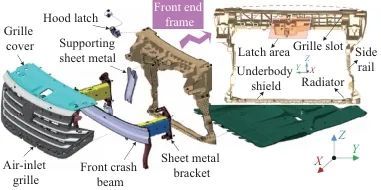
Fig. 1 Overall assembly diagram of the front-end frame
In terms of the main structure, the front-end framework is composed of the hood latch, grille slot, radiator, underbody shield, and left and right side beams. At the same time, several installation holes for the condenser are arranged on the side beams and underbody shield to enhance the module integration. Engineering practice shows that the one-piece injection-molded front-end framework will experience a certain degree of warpage deformation. When the maximum deformation exceeds the process standard value, it affects the assembly accuracy between the front-end framework and the integrated components. Therefore, with the help of injection molding CAE technology, it is possible to simulate the plastic material forming process in advance, thereby reducing the number of trial moldings and significantly shortening the product development cycle.
Import the 3D model into Moldflow to generate a dual-layer mesh. After repairing with the mesh tool, obtain the mesh quality parameters as shown in Figure 2. The overall dimensions are 1,100 mm × 989 mm × 290 mm, with 230,926 triangular meshes. The maximum aspect ratio is 14.99, the average is 2.12, and the mesh matching percentage reaches 90.5%. The number of intersecting and overlapping edges is 0, and all quality indicators meet the requirements for finite element analysis. Considering the actual installation conditions, fixed constraints are applied at the mounting hole positions of the front-end frame.
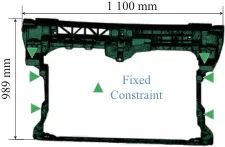
Fig. 2 Mesh model of automobile front-end frame
The long glass fiber reinforced polypropylene polymer (PP/30%LGF) is selected as the molding material, which is composed of polypropylene with 30% by mass of long glass fibers, possessing advantages such as high impact resistance, wear resistance, and weight reduction and cost saving [12]. Studies have shown that the warpage deformation and other defects produced during the processing of polymers are related to changes in specific volume, and the pressure-volume-temperature (PVT) curve describes the characteristic relationship between the specific volume of the polymer and temperature and pressure [13]. Figure 3 shows the change curve of the volume shrinkage rate (specific volume) per unit mass of PP/30%LGF with temperature and pressure factors, which can be used to predict the warpage defects of injection molded parts and also provides a reference for the parameter input part of the mold flow analysis software Moldflow.
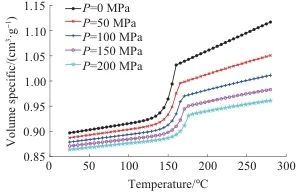
Fig. 3 PVT curves of PP/30%LGF
1.3 Warp Deformation Analysis
Front-end framework belongs to thin-walled shell injection molding parts. The final product will warp and deform due to uneven density. When the deformation exceeds the standard tolerance, it can cause excessive assembly clearance of the components, thereby affecting the reliability of the entire vehicle. According to the product injection molding process, a gating and cooling system is established in the Moldflow mold flow analysis software (as shown in Figure 4). The "filling + packing + cooling + warpage" analysis sequence is selected. The filling control adopts the method of specifying the time required for complete part filling, and the velocity/pressure (V/P) switch occurs when the filling volume percentage reaches 98%. Based on the initial process parameters, the maximum Z-direction warpage deformation at the product grille slot is 2.423 mm (as shown in Figure 5). The specific process parameters are as follows: mold temperature (A) 40 ℃, melt temperature (B) 235 ℃, packing pressure (C) 30 MPa, packing time (D) 2 s, cooling time (E) 20 s. It should be noted that the optimized process parameter of melt temperature refers to the temperature of the melt flowing out from the nozzle of the hot runner system in Figure 4; the packing pressure and packing time are the control parameters of the second set of sequential valves.
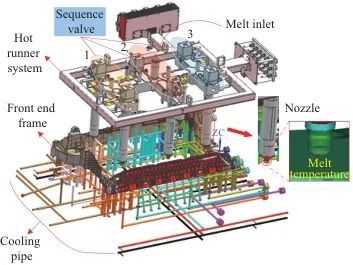
Fig. 4 Design for gating and cooling system
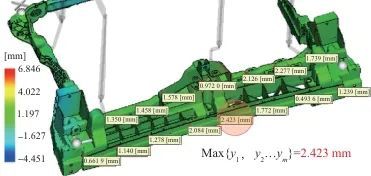
Fig. 5 Warping deformation with initial process parameters
2.1 Orthogonal Experiment Design
To clarify the influence of forming process parameters on the warpage deformation of the front-end frame, an orthogonal experimental design method was adopted. Mold temperature (A), melt temperature (B), packing pressure (C), packing time (D), and cooling time (E) were taken as experimental factors, with warpage deformation (Y) as the optimization index. A 5-factor 5-level orthogonal test condition was established. The level values of each factor were determined based on actual process experience parameters, as shown in Table 1.
Table 1 Process parameters and levels under orthogonal test
3 Optimization of Process Parameters Based on Intelligent Algorithms
Orthogonal test method seeks the optimal solution within a representative set of 25 experimental trials. Given that the factor levels are set within the range of empirical values, this leads to limitations in the optimization results. To accurately obtain the nonlinear functional relationship between process parameters and warpage deformation, and to achieve the optimal experimental results, the author leverages the strong nonlinear fitting capability of the BP neural network to establish a mathematical model for the process parameter optimization problem. By combining the global optimization characteristics of the GA genetic algorithm, the optimal weights and thresholds suitable for the neural network model are obtained. After training with existing orthogonal test data, the network model can predict the target result with the minimum mean square error. The flowchart of the GA-BP algorithm is shown in Figure 6.
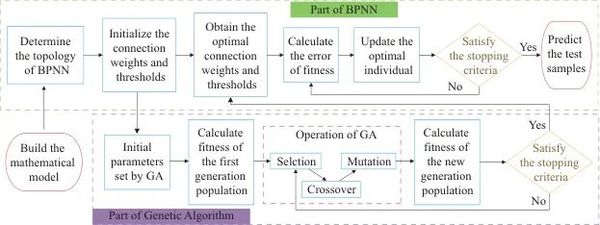
Fig. 6 Flow chart of GA-BP optimizing algorithm
3.1 BP Neural Network Construction
BP neural network is a multi-layer feedforward network model with forward signal transmission and backward error propagation. The working mechanism is described as: sample data from the input layer is transmitted to the output layer through hidden layer neurons. When the expected result does not meet the anticipated output, the prediction error is calculated and propagated backward. By iteratively adjusting the connection weights of neurons in each layer, the goal is to achieve the desired output with the minimum mean square error [14-15].
A 3-layer 5-11-1 structured BP neural network model is adopted, selecting 5 process parameters from orthogonal experiments as input layer neurons (number of nodes i=5), the warpage deformation amount as the output layer neuron (number of nodes k=1), with 11 hidden layer nodes (j=11). The layers are connected through weights and thresholds, as shown in Figure 7.

Fig. 7 BP neural network structural model
To make the prediction results of the neural network model more accurate, 1 to 20 groups of data from orthogonal test tables are introduced as the training sample set, and the last 5 groups are used as the prediction samples. During the training process, the mapping relationship between the input variables and the expected output of the BP neural network can be written as equation (2) based on the objective function in equation (1).
 In the equation: M is the optimization target object (warping deformation); X = [x1, x2, …, x5], representing a matrix composed of 5 types of process parameter values; f_l is the linear transfer function purelin between the output layer and the hidden layer; f_s is the transfer function tansig reflecting the mapping relationship between the hidden layer and the input layer; wij represents the weight coefficient matrix from the input layer to the hidden layer; wjk represents the weight coefficient matrix from the hidden layer to the output layer, where i = 1, 2…, 5; j = 1, 2…, 11.
Two types of transfer function expressions are shown in equation (3).
Introduce the mean squared error MSE to measure the fitting accuracy of the predicted sample set. Generally, the smaller the MSE value, the higher the prediction accuracy, as expressed in equation (4).
In the equation: n is the number of prediction samples; g(x) is the predicted value; y is the actual output value.
In the equation: M is the optimization target object (warping deformation); X = [x1, x2, …, x5], representing a matrix composed of 5 types of process parameter values; f_l is the linear transfer function purelin between the output layer and the hidden layer; f_s is the transfer function tansig reflecting the mapping relationship between the hidden layer and the input layer; wij represents the weight coefficient matrix from the input layer to the hidden layer; wjk represents the weight coefficient matrix from the hidden layer to the output layer, where i = 1, 2…, 5; j = 1, 2…, 11.
Two types of transfer function expressions are shown in equation (3).
Introduce the mean squared error MSE to measure the fitting accuracy of the predicted sample set. Generally, the smaller the MSE value, the higher the prediction accuracy, as expressed in equation (4).
In the equation: n is the number of prediction samples; g(x) is the predicted value; y is the actual output value.
3.2 GA Algorithm Optimization
Due to the initial weights and thresholds of the BP neural network being randomly selected, it is prone to falling into a local minimum solution set [16], while genetic algorithms possess strong global search capabilities through parallel computing, selecting individuals with smaller fitness values through selection, crossover, and mutation operations, making them suitable for extreme value optimization of functions, combination parameter optimization, and production scheduling, etc. [17].
First, initialize the population elements. Individuals adopt real number encoding methods, with the weights and thresholds of each layer of the neural network stored in chromosomes as a string of real number genes for evolution through generations. The individual coding length L is determined to be 78 by calculation according to formula (5). The sum of the absolute values of the errors between the predicted output and the experimental results is used as the individual fitness value F, the calculation formula of which is shown in formula (6).
In the formula: m is the number of prediction output nodes in the BP neural network; gi is the predicted output of the i-th node in the neural network; yi is the actual output of the i-th node; k is the coefficient.
Based on the roulette wheel selection method to choose the regeneration operator, the selection probability pi for each individual i is shown in equation (7).
In the equation: Fi is the fitness value of individual i; fi is the reciprocal of Fi; K is a coefficient; N is the number of individuals in the population.
Adopting the discrete crossover method, the crossover operation at position j between the h-th chromosome ah and the l-th chromosome al is shown in equation (8).
In the formula: b is a random number in the [0, 1] interval.
Generate new chromosomes through basic bit mutation, the mutation operation method for the jth gene aij of the ith chromosome is shown in equation (9).
In the equation: amax, amin are the upper and lower bounds of gene aij, respectively; g is the current iteration number; Gmax is the maximum number of reproductions; r2 is a random number; r is a random number in the [0, 1] interval.
Based on the BP neural network model and GA genetic optimization algorithm theory, the algorithm for the GA-BP neural network nonlinear system is developed in the MATLAB programming environment. The genetic algorithm parameters are set as follows: population size is 50, the maximum number of generations Gmax is 150, the crossover probability is 0.4, and the mutation probability is 0.2. The fitness curve in Figure 8 shows that the fitness value gradually decreases with the evolution of generations, and the curve tends to converge at the 68th generation, indicating that the GA algorithm has found the optimal initial weights and thresholds for the BP network.
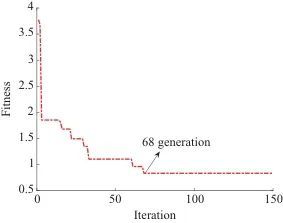
Fig. 8 Iteration curve optimized by GA algorithm
Figure 9 shows the comparison between GA-BP prediction values and actual results. The prediction results in Figure 9 indicate that the 5 sets of test samples have a high degree of fit with the actual experimental values, with a maximum relative error of 7.12% and an average relative error of 4.28%, proving the accuracy of the GA-BP neural network prediction model. Finally, after solving with an optimization algorithm, the optimal injection molding process parameters are obtained as: mold temperature 60 ℃, melt temperature 265 ℃, holding pressure 55 MPa, holding time 4 s, cooling time 35 s, and the predicted warpage deformation is 1.191 mm.
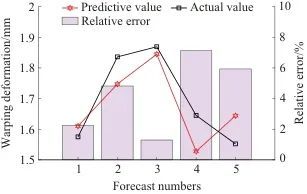
Fig. 9 Actual and predicted values comparison of GA-BP
4.1 Moldflow Numerical Simulation Verification
The optimal process parameters predicted by the GA-BP neural network model were input into the Moldflow software for finite element simulation verification, obtaining the Z-direction warpage deformation distribution values along the length direction of the front-end frame grille slots. The numerical simulation comparison results before and after optimization are shown in Figure 10. After optimization, the maximum warpage deformation of the front-end frame grille slots was reduced to 1.33 mm, and the average deformation decreased to 0.57 mm. Compared with the pre-optimization maximum warpage deformation of 2.423 mm and the average of 1.386 mm, the maximum and average warpage deformations after optimization decreased by 45.1% and 58.8%, respectively. The post-optimization simulation result, compared with the maximum warpage of 1.191 mm predicted by the GA-BP neural network model, differed by only 0.139 mm, with a relative error of 10.5%, making the warpage deviation acceptable. The process parameters obtained from the GA-BP model solution were applied in the trial mold injection production stage, and the manufactured front-end frame is shown in Figure 11. Figure 11 sequentially displays the 3D design model of the front-end frame, the overall injection-molded object, and the local grille slot area.
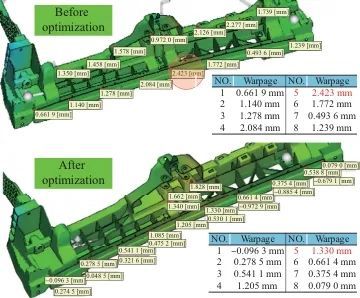
Fig. 10 Comparison of results before and after Moldflow optimization
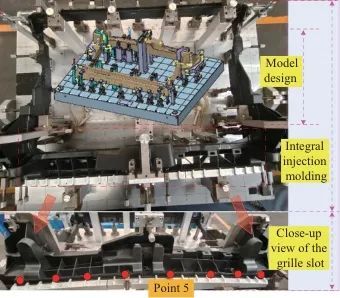
Fig. 11 Front frame injection molding object
4.2 CMM experimental verification
Adopt the Hexagon-Global series coordinate measuring machine (CMM) to measure the deviation of each point in the grille slot area of the front-end frame injection molded parts. The measurement system is equipped with a 6-degree-of-freedom high-precision trigger probe, which can achieve rapid and precise measurement of complex contour surface components, with a scanning sampling frequency of capturing 6×10^5 point cloud data per second, and a measurement accuracy of up to 0.001 mm, the probe radius value is 1 mm. The values measured by the CMM are actually the relative position deviations between the physical object to be measured and the corresponding points of the design model, characterized by T value, positive and negative values of the position points represent the protruding and recessed states of the product (Figure 12). The specific operation steps are as follows: (1) Import the design model into the system software and simulate to obtain the theoretical position coordinates of the product; (2) Fix the fixture on the worktable and establish a standard spatial coordinate system based on the positioning holes; (3) Fix the injection molded part to be measured on the fixture through the positioning holes; (4) Move the CMM probe to measure the target position and obtain the calculated deviation value.
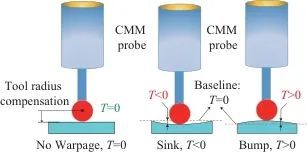
Fig. 12 Warping deformation state measured by CMM
The actual measured deviation values are shown in Figure 13, extracting measurement points at specific length intervals, and integrating the numerical simulation points before and after the front-end framework optimization (Figure 10) for plotting and comparison. Figure 14 shows that there is a consistent trend of curve changes between the experimental measurement deviations and the warpage values of the numerical simulations before and after Moldflow optimization, with all three having their maximum value points appearing at the position of the grille slot lock area (see point 5 in Figure 11), then decreasing along both sides. The average error between the optimized numerical calculation results and the experimental measurement results is 0.28 mm, with the maximum errors concentrated at points 4 and 5 in the lock area, with differences of 0.782 mm and 0.679 mm, respectively. Considering the fluctuations in simulation parameters, manufacturing tolerances, measurement deviations, and other factors, as well as the ±1 mm dimensional tolerance requirement for the grille slot area, the injection-molded part can meet the process assembly dimensional requirements. Overall, the optimized simulation results have certain guiding significance for actual production.
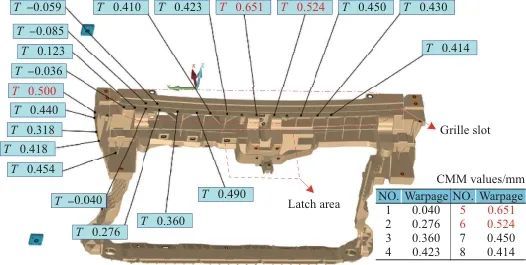
Fig. 13 CMM deviation measurement value
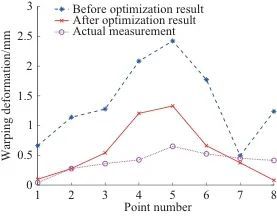
Fig. 14 Comparison values between before/after Moldflow simulation and actual measurement
Based on the Moldflow software, a warpage deformation analysis of the automotive front-end frame grille slots was conducted, and it was found that the maximum deformation under initial process conditions reached 2.423 mm. Through orthogonal experimental methods, the mapping relationship between 5 process factors and the warpage deformation was obtained, and a BP neural network mathematical model describing the optimization objective was established.
(2) Introduce GA algorithm to optimize the weights and thresholds of BP neural network, and predict the optimal process parameters as: mold temperature 60 ℃, melt temperature 265 ℃, holding pressure 55 MPa, holding time 4 s, cooling time 35 s. The Moldflow warpage deformation simulation value under the corresponding process conditions is 1.33 mm, which is a reduction of 45.1% compared to the pre-optimization warpage deformation of 2.423 mm, indicating a significant optimization effect.
(3) The optimal process parameters predicted by the neural network model were used in the actual production process to manufacture the front-end frame. A coordinate measuring machine was used to measure the deviation values of each point in the grille slot area. By comparing the Moldflow simulation values before and after optimization with the actual measurement results, it was found that there is a consistent trend in the distribution of the warpage values. The numerical results after optimization are closer to the actual measurement results, with an average error of 0.28 mm, thus verifying the accuracy and feasibility of the GA-BP neural network model in predicting process parameters, and also reducing the product development cost.
【Copyright and Disclaimer】The above information is collected and organized by PlastMatch. The copyright belongs to the original author. This article is reprinted for the purpose of providing more information, and it does not imply that PlastMatch endorses the views expressed in the article or guarantees its accuracy. If there are any errors in the source attribution or if your legitimate rights have been infringed, please contact us, and we will promptly correct or remove the content. If other media, websites, or individuals use the aforementioned content, they must clearly indicate the original source and origin of the work and assume legal responsibility on their own.





